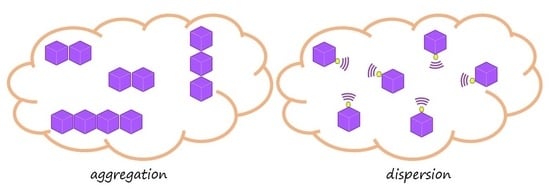The Rediscovery of POSS: A Molecule Rather than a Filler
Abstract
:1. Introduction
2. Experimental
2.1. Nomenclature
2.2. Materials
3. Results and Discussion
3.1. Incorporation of POSS in Polymer Matrix
3.2. The Importance of POSSs Asymmetric Structure in Designing Composites
3.3. The Influence of POSSs External Groups’ Rigidity on Solubility and Thermal Behaviour
3.4. The Use of Dumbbell-Shaped POSSs in Reinforcing Polymer Matrix
4. Conclusions
Funding
Conflicts of Interest
References
- Hartmann-Thompson, C. Applications of Polyhedral Oligomeric Silsesquioxanes; Springer: New York, NY, USA, 2011; ISBN 978-90-481-3786-2. [Google Scholar] [CrossRef]
- Mezzenga, R.; Boogh, L.; Månson, J.-A.E. A review of dendritic hyperbranched polymer as modifiers in epoxy composites. Compos. Sci. Technol. 2001, 61, 787–795. [Google Scholar] [CrossRef]
- Díaz, I.; García, B.; Alonso, B.; Casado, C.M.; Morán, M.; Losada, J.; Pérez-Pariente, J. Ferrocenyl dendrimers incorporated into mesoporous silica: New hybrid redox-active materials. Chem. Mater. 2003, 15, 1073–1079. [Google Scholar] [CrossRef]
- Liu, H.; Guo, J.; Jin, L.; Yang, W.; Wang, C. Fabrication and functionalization of dendritic poly(amidoamine)-immobilized magnetic polymer composite microspheres. J. Phys. Chem. B 2008, 112, 3315–3321. [Google Scholar] [CrossRef] [PubMed]
- Punetha, V.D.; Rana, S.; Yoo, H.J.; Chaurasia, A.; McLeskey, J.T., Jr.; Ramasamy, M.S.; Sahoo, N.G.; Cho, J.W. Functionalization of carbon nanomaterials for advanced polymer nanocomposites: A comparison study between CNT and graphene. Prog. Polym. Sci. 2017, 67, 1–47. [Google Scholar] [CrossRef]
- Vorobyeva, E.A.; Chechenin, N.G.; Makarenko, I.V.; Kepman, A.V. Heat Propagation in Anisotropic Heterogeneous Polymer-CNT Composites. J. Compos. Sci. 2017, 1, 6. [Google Scholar] [CrossRef]
- Bertolino, V.; Cavallaro, G.; Milioto, S.; Parisi, F.; Lazzara, G. Thermal Properties of Multilayer Nanocomposites Based on Halloysite Nanotubes and Biopolymers. J. Compos. Sci. 2018, 2, 41. [Google Scholar] [CrossRef]
- Kuilla, T.; Bhadra, S.; Yao, D.; Kim, N.H.; Bose, S.; Lee, J.H. Recent advances in graphene based polymer composites. Progr. Polym. Sci. 2010, 35, 1350–1375. [Google Scholar] [CrossRef]
- Wang, H.; Hao, Q.; Yang, X.; Lu, L.; Wang, X. A nanostructured graphene/polyaniline hybrid material for supercapacitors. Nanoscale 2010, 2, 2164–2170. [Google Scholar] [CrossRef] [PubMed]
- Shahil, K.M.F.; Balandin, A.A. Graphene-multilayer graphene nanocomposites as highly efficient thermal interface materials. Nano Lett. 2012, 12, 861–867. [Google Scholar] [CrossRef] [PubMed]
- Wang, C.; Guo, Z.-X.; Fu, S.; Wu, W.; Zhu, D. Polymers containing fullerene or carbon nanotube structures. Prog. Polym. Sci. 2004, 29, 1079–1141. [Google Scholar] [CrossRef]
- Tenne, R.; Enyashin, A.N. Inorganic Fullerene-Like Nanoparticles and Inorganic Nanotubes. Inorganics 2014, 2, 649–651. [Google Scholar] [CrossRef]
- Zhao, D.; Ning, J.; Wu, D.; Zuo, M. Enhanced Thermoelectric Performance of Cu2SnSe3-Based Composites Incorporated with Nano-Fullerene. Materials 2016, 9, 629. [Google Scholar] [CrossRef] [PubMed]
- Blanco, I.; Bottino, F.A.; Cicala, G.; Latteri, A.; Recca, A. A kinetic study of the thermal and thermal oxidative degradations of new bridged POSS/PS nanocomposites. Polym. Degrad. Stab. 2013, 98, 2564–2570. [Google Scholar] [CrossRef]
- Carraro, M.; Gross, S. Hybrid Materials Based on the Embedding of Organically Modified Transition Metal Oxoclusters or Polyoxometalates into Polymers for Functional Applications: A Review. Materials 2014, 7, 3956–3989. [Google Scholar] [CrossRef] [PubMed] [Green Version]
- Wang, K.; Pasbakhsh, P.; De Silva, R.T.; Goh, K.L. A Comparative Analysis of the Reinforcing Efficiency of Silsesquioxane Nanoparticles versus Apatite Nanoparticles in Chitosan Biocomposite Fibres. J. Compos. Sci. 2017, 1, 9. [Google Scholar] [CrossRef]
- Buff, H.; Wohler, F. Ueber neue Verbindungen des Siliciums. Liebigs Ann. Chem. 1857, 104, 94–109. [Google Scholar] [CrossRef]
- Ladenburg, A. Ueber aromatische Verbindungen, welche Silicium enthalten. Ber. Dtsch. Chem. Ges. 1873, 6, 379–381. [Google Scholar] [CrossRef]
- Scott, D.W. Thermal Rearrangement of Branched-Chain Methylpolysiloxanes. J. Am. Chem. Soc. 1946, 68, 356–358. [Google Scholar] [CrossRef]
- Barry, A.J.; Daudt, W.H.; Domicone, J.J.; Gilkey, J.W. Crystalline Organosilsesquioxanes. J. Am. Chem. Soc. 1955, 77, 4248–4252. [Google Scholar] [CrossRef]
- Feher, F.J. Polyhedral Oligometallasilsesquioxanes (POMSS) as Models for Silica-Supported Transiton-Metal Catalysts: Synthesis and Characterization of (C5Me5)Zr[(Si7O12)(c-C6H11)7]. J. Am. Chem. Soc. 1986, 108, 3850–3852. [Google Scholar] [CrossRef]
- Feher, F.J.; Budzichowski, T.A. Syntheses of highly-functionalized polyhedral oligosilsesquioxanes. J. Organomet. Chem. 1989, 379, 33–40. [Google Scholar] [CrossRef]
- Lichtenhan, J.D. Polyhedral Oligomeric Silsesquioxanes: Building Blocks for Silsesquioxane-Based Polymers and Hybrid Materials. Comments Inorg. Chem. 1995, 17, 115–130. [Google Scholar] [CrossRef]
- Haddad, T.S.; Lichtenhan, J.D. Hybrid organic-inorganic thermoplastics: Styryl-based polyhedral oligomeric silsesquioxane polymers. Macromolecules 1996, 29, 7302–7304. [Google Scholar] [CrossRef]
- Blanco, I.; Abate, L.; Bottino, F.A. Influence of n-alkyl substituents on the thermal behaviour of Polyhedral Oligomeric Silsesquioxanes (POSSs) with different cage’s periphery. Thermochim. Acta 2016, 623, 50–57. [Google Scholar] [CrossRef]
- Lee, J.Y.; Fu, G.C. Room-temperature Hiyama cross-couplings of arylsilanes with alkyl bromides and iodides. J. Am. Chem. Soc. 2003, 125, 5616–5617. [Google Scholar] [CrossRef] [PubMed]
- Murata, M.; Ishikura, M.; Nagata, M.; Watanabe, S.; Masuda, Y. Rhodium (I)-catalyzed silylation of aryl halides with triethoxysilane: Practical synthetic route to aryltriethoxysilanes. Org. Lett. 2002, 4, 1843–1845. [Google Scholar] [CrossRef] [PubMed]
- Weber, W.P. Silicon Reagents for Organic Synthesis; Springer: Berlin/Heidelberg, Germany, 1983; ISBN 978-3-642-68663-4. [Google Scholar] [CrossRef]
- Manoso, A.S.; Ahn, C.; Soheili, A.; Handy, C.J.; Correia, R.; Seganish, W.M.; Deshong, P. Improved synthesis of aryltrialkoxysilanes via treatment of aryl grignard or lithium reagents with tetraalkyl orthosilicates. J. Org. Chem. 2004, 69, 8305–8314. [Google Scholar] [CrossRef] [PubMed]
- Lichtenhan, J.D.; Schwab, J.J.; Reinerth, W.; Carr, M.J.; An, Y.Z.; Feher, F.J.; Terroba, R.; Liu, Q. Process for the Formation of Polyhedral Oligomeric Silsesquioxanes. U.S. Patent 6,972,312 B1, 6 December 2005. [Google Scholar]
- Dou, Q.; Karim, A.A.; Loh, X.J. Modification of Thermal and Mechanical Properties of PEG-PPG-PEG Copolymer (F127) with MA-POSS. Polymers 2016, 8, 341. [Google Scholar] [CrossRef]
- Mohamed, M.G.; Jheng, Y.-R.; Yeh, S.-L.; Chen, T.; Kuo, S.-W. Unusual Emission of Polystyrene-Based Alternating Copolymers Incorporating Aminobutyl Maleimide Fluorophore-Containing Polyhedral Oligomeric Silsesquioxane Nanoparticles. Polymers 2017, 9, 103. [Google Scholar] [CrossRef]
- Huang, C.-W.; Jeng, S.-C. Polyhedral Oligomeric Silsesquioxane Films for Liquid Crystal Alignment. Coll. Interfaces 2018, 2, 9. [Google Scholar] [CrossRef]
- Li, X.; Yu, B.; Zhang, D.; Lei, J.; Nan, Z. Cure Behavior and Thermomechanical Properties of Phthalonitrile–Polyhedral Oligomeric Silsesquioxane Copolymers. Polymers 2017, 9, 334. [Google Scholar] [CrossRef]
- De Armitt, C.; Wheeler, P. POSS keeps high temperature plastics flowing. Plast. Addit. Compd. 2008, 10, 36–39. [Google Scholar] [CrossRef]
- Blanco, I.; Bottino, F.A.; Cicala, G.; Latteri, A.; Recca, A. Synthesis and characterization of differently substituted phenyl hepta isobutyl-polyhedral oligomeric silsesquioxane/polystyrene nanocomposites. Polym. Compos. 2014, 35, 151–157. [Google Scholar] [CrossRef]
- Kim, K.; Alam, T.M.; Lichtenhan, J.D.; Otaigbe, J.U. Synthesis and characterization of novel phosphate glass matrix nanocomposites containing polyhedral oligomeric silsesquioxane with improved properties. J. Non-Cryst. Solids 2017, 463, 189–202. [Google Scholar] [CrossRef]
- Michałowski, S.; Hebda, E.; Pielichowski, K. Thermal stability and flammability of polyurethane foams chemically reinforced with POSS. J. Therm. Anal. Calorim. 2017, 130, 155–163. [Google Scholar] [CrossRef] [Green Version]
- Blanco, I.; Abate, L.; Bottino, F.A. Mono substituted octaphenyl POSSs: The effects of substituents on thermal properties and solubility. Thermochim. Acta 2017, 655, 117–123. [Google Scholar] [CrossRef]
- Li, S.; Simon, G.P.; Matisons, J.G. The effect of incorporation of POSS units on polymer blend compatibility. J. Appl. Polym. Sci. 2010, 115, 1153–1159. [Google Scholar] [CrossRef]
- Blanco, I.; Bottino, F.A. The influence of the nature of POSSs cage’s periphery on the thermal stability of a series of new bridged POSS/PS nanocomposites. Polym. Degrad. Stab. 2015, 121, 180–186. [Google Scholar] [CrossRef]
- Ueda, K.; Tanaka, K.; Chujo, Y. Synthesis of POSS Derivatives Having Dual Types of Alkyl Substituents and Their Application as a Molecular Filler for Low-Refractive and Highly Durable Materials. Bull. Chem. Soc. Jpn. 2017, 90, 205–209. [Google Scholar] [CrossRef] [Green Version]
- Fina, A.; Tabuani, D.; Carniato, F.; Frache, A.; Boccaleri, E.; Camino, G. Polyhedral oligomeric silsesquioxanes (POSS) thermal degradation. Thermochim. Acta 2006, 440, 36–42. [Google Scholar] [CrossRef]
- Blanco, I.; Abate, L.; Bottino, F.A.; Cicala, G.; Latteri, A. Dumbbell-shaped polyhedral oligomeric silsesquioxanes/polystyrene nanocomposites: The influence of the bridge rigidity on the resistance to thermal degradation. J. Compos. Mater. 2015, 49, 2509–2517. [Google Scholar] [CrossRef]
- Blanco, I.; Abate, L.; Bottino, F.A.; Bottino, P.; Chiacchio, M.A. Thermal degradation of differently substituted cyclopentyl polyhedral oligomeric silsesquioxane (CP-POSS) nanoparticles. J. Therm. Anal. Calorim. 2012, 107, 1083–1091. [Google Scholar] [CrossRef]
- Blanco, I.; Abate, L.; Bottino, F.A.; Bottino, P. Hepta isobutyl polyhedral oligomeric silsesquioxanes (hib-POSS) A thermal degradation study. J. Therm. Anal. Calorim. 2012, 108, 807–815. [Google Scholar] [CrossRef]
- Blanco, I.; Abate, L.; Bottino, F.A.; Bottino, P. Thermal degradation of hepta cyclopentyl, mono phenyl-polyhedral oligomeric silsesquioxane (hcp-POSS)/polystyrene (PS) nanocomposites. Polym. Degrad. Stab. 2012, 97, 849–855. [Google Scholar] [CrossRef]
- Blanco, I.; Abate, L.; Antonelli, M.L.; Bottino, F.A.; Bottino, P. Phenyl hepta cyclopentyl–polyhedral oligomeric silsesquioxane (ph,hcp-POSS)/Polystyrene (PS) nanocomposites: The influence of substituents in the phenyl group on the thermal stability. eXPRESS Polym. Lett. 2012, 6, 997–1006. [Google Scholar] [CrossRef] [Green Version]
- Blanco, I.; Bottino, F.A. Thermal Study on Phenyl, Hepta Isobutyl-Polyhedral Oligomeric Silsesquioxane/Polystyrene Nanocomposites. Polym. Compos. 2013, 34, 225–232. [Google Scholar] [CrossRef]
- Blanco, I.; Bottino, F.A.; Bottino, P. Influence of symmetry/asymmetry of the nanoparticles structure on the thermal stability of polyhedral oligomeric silsesquioxane/polystyrene nanocomposites. Polym. Compos. 2012, 33, 1903–1910. [Google Scholar] [CrossRef]
- Blanco, I.; Bottino, F.A.; Cicala, G.; Latteria, A.; Recca, A. Synthesis and thermal characterization of mono alkyl hepta phenyl POSS/PS nanocomposites. Polym. Degrad. Stab. 2016, 134, 322–327. [Google Scholar] [CrossRef]
- Araki, H.; Naka, K. Syntheses of Dumbbell-Shaped Trifluoropropyl-Substituted POSS Derivatives Linked by Simple Aliphatic Chains and Their Optical Transparent Thermoplastic Films. Macromolecules 2011, 44, 6039–6045. [Google Scholar] [CrossRef]
- Araki, H.; Naka, K. Syntheses and Properties of Star- and Dumbbell-Shaped POSS Derivatives Containing Isobutyl Groups. Polym. J. 2012, 44, 340–346. [Google Scholar] [CrossRef]
- Araki, H.; Naka, K. Syntheses and Properties of Dumbbell-Shaped POSS Derivatives Linked by Luminescent π-Conjugated Units. J. Polym. Sci. Part A Polym. Chem. 2012, 50, 4170–4181. [Google Scholar] [CrossRef]
- Spoljaric, S.; Genovese, A.; Shanks, R.A. Novel elastomer-dumbbell functionalized POSS composites: Thermomechanical and Morphological Properties. J. Appl. Polym. Sci. 2012, 123, 585–600. [Google Scholar] [CrossRef]
- Abate, L.; Blanco, I.; Cicala, G.; La Spina, R.; Restuccia, C.L. Thermal and rheological behaviour of some random aromatic polyethersulfone/polyetherethersulfone copolymers. Polym. Degrad. Stab. 2006, 91, 924–930. [Google Scholar] [CrossRef]
- Abate, L.; Blanco, I.; Cicala, G.; Recca, G.; Scamporrino, A. The influence of chain-ends on the thermal and rheological properties of some 40/60 PES/PEES copolymers. Polym. Eng. Sci. 2009, 49, 1477–1483. [Google Scholar] [CrossRef]
- Abate, L.; Asarisi, V.; Blanco, I.; Cicala, G.; Recca, G. The influence of sulfonation degree on the thermal behaviour of sulfonated poly(arylene ethersulfone)s. Polym. Degrad. Stab. 2010, 95, 1568–1574. [Google Scholar] [CrossRef]
- Blanco, I.; Abate, L.; Bottino, F.A.; Bottino, P. Synthesis, characterization and thermal stability of new dumbbell-shaped isobutyl-substituted POSSs linked by aromatic bridges. J. Therm. Anal. Calorim. 2014, 117, 243–250. [Google Scholar] [CrossRef]
- Blanco, I.; Abate, L.; Bottino, F.A. Synthesis and thermal properties of new dumbbell-shaped isobutyl-substituted POSSs linked by aliphatic bridges. J. Therm. Anal. Calorim. 2014, 116, 5–13. [Google Scholar] [CrossRef]
- Blanco, I.; Abate, L.; Bottino, F.A.; Bottino, P. Thermal behaviour of a series of novel aliphatic bridged polyhedral oligomeric silsesquioxanes (POSSs)/polystyrene (PS) nanocomposites: The influence of the bridge length on the resistance to thermal degradation. Polym. Degrad. Stab. 2014, 102, 132–137. [Google Scholar] [CrossRef]
- Tanaka, K.; Adachi, S.; Chujo, Y. Structure–property relationship of octa-substituted POSS in thermal and mechanical reinforcements of conventional polymers. J. Polym. Sci. Part A Polym. Chem. 2009, 47, 5690–5697. [Google Scholar] [CrossRef]
- Moore, B.M.; Ramirez, S.M.; Yandeka, G.R.; Haddad, T.S.; Mabry, J.M. Asymmetric aryl polyhedral oligomeric silsesquioxanes (ArPOSS) with enhanced solubility. J. Organomet. Chem. 2011, 696, 2676–2680. [Google Scholar] [CrossRef]
- Huang, M.; Yue, K.; Huang, J.; Liu, C.; Zhou, Z.; Wang, J.; Wu, K.; Shan, W.; Shi, A.C.; Cheng, S.Z.D. Highly Asymmetric Phase Behaviors of Polyhedral Oligomeric Silsesquioxane-Based Multiheaded Giant Surfactants. ACS Nano 2018, 12, 1868–1877. [Google Scholar] [CrossRef] [PubMed]
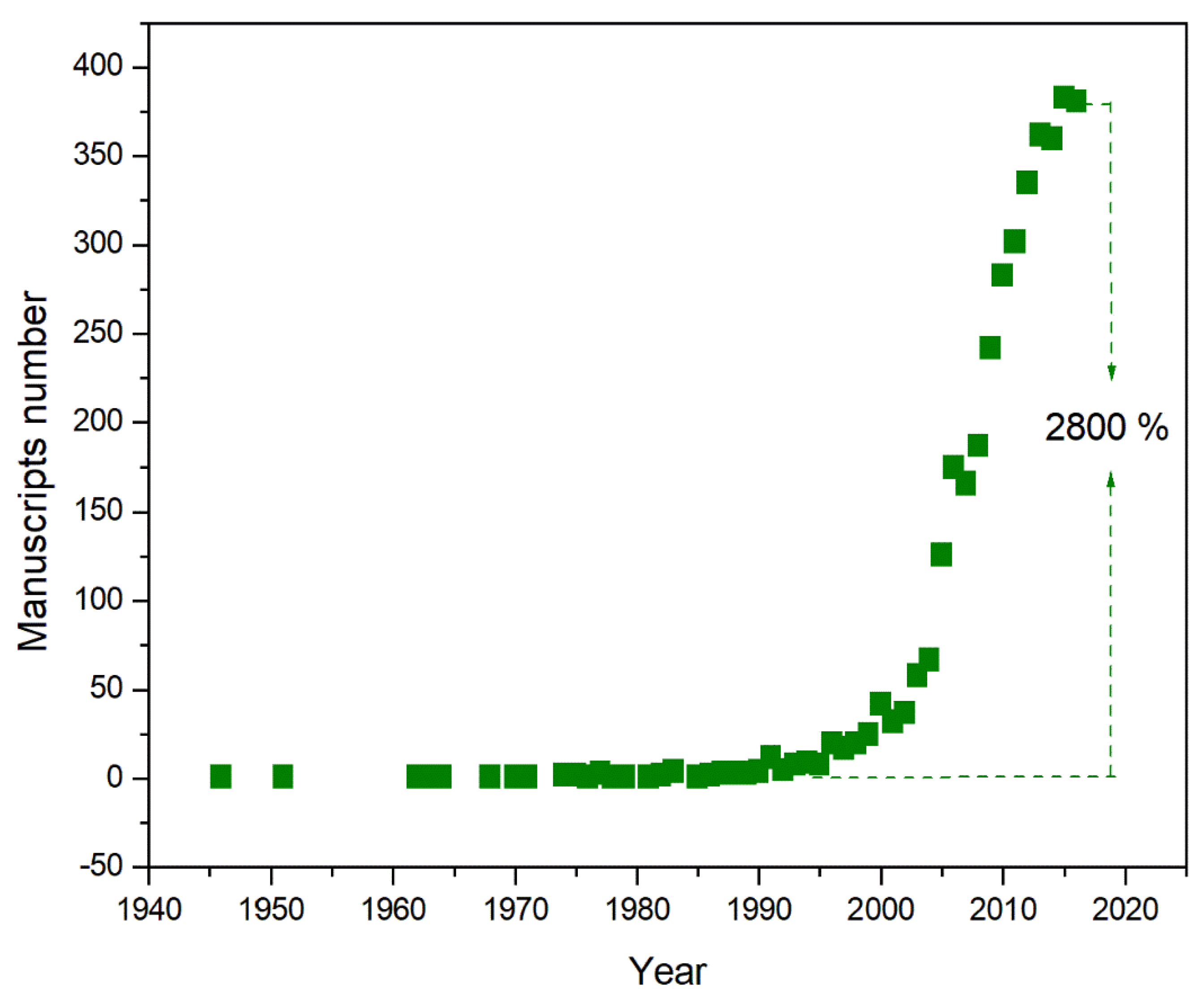
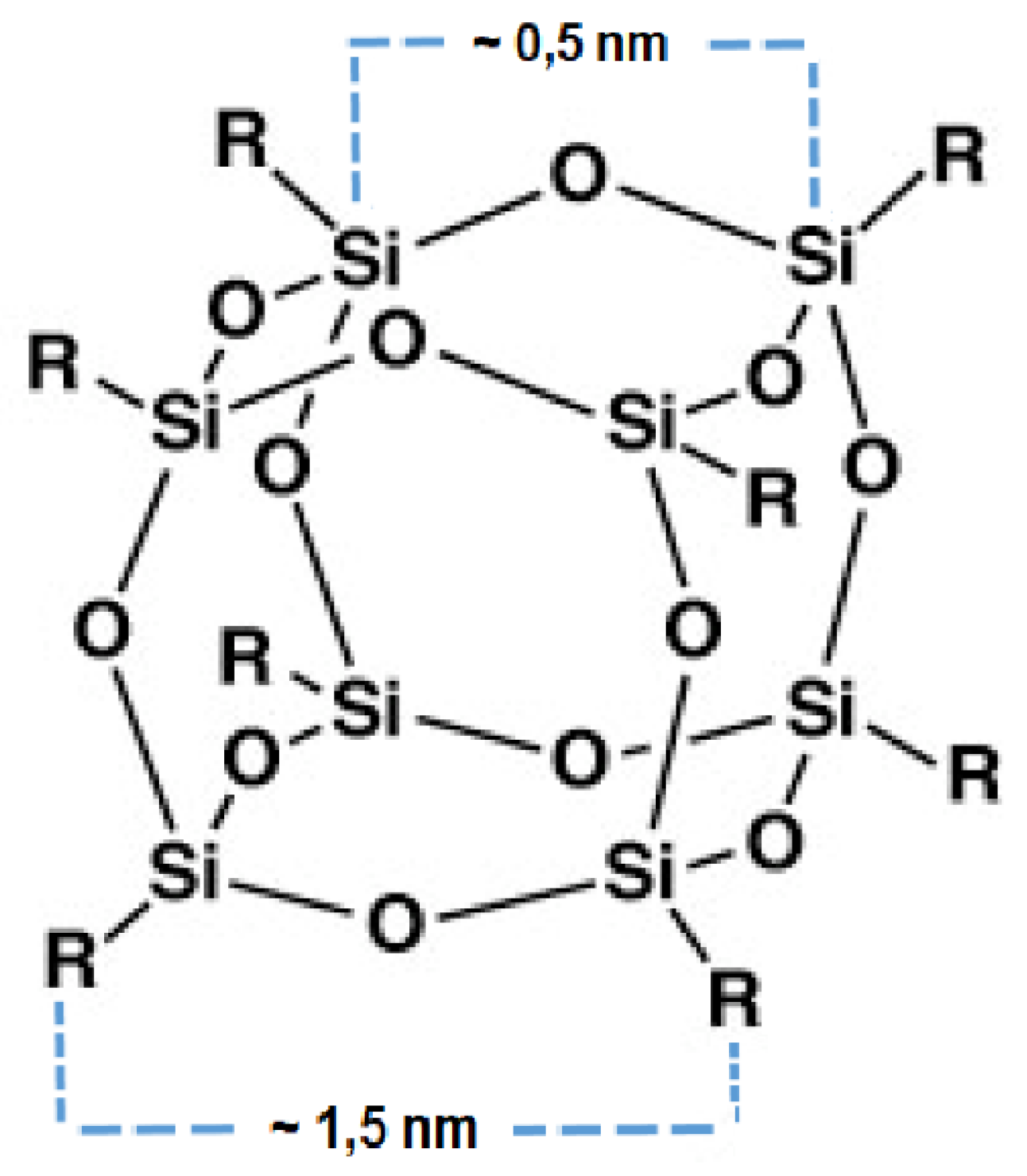

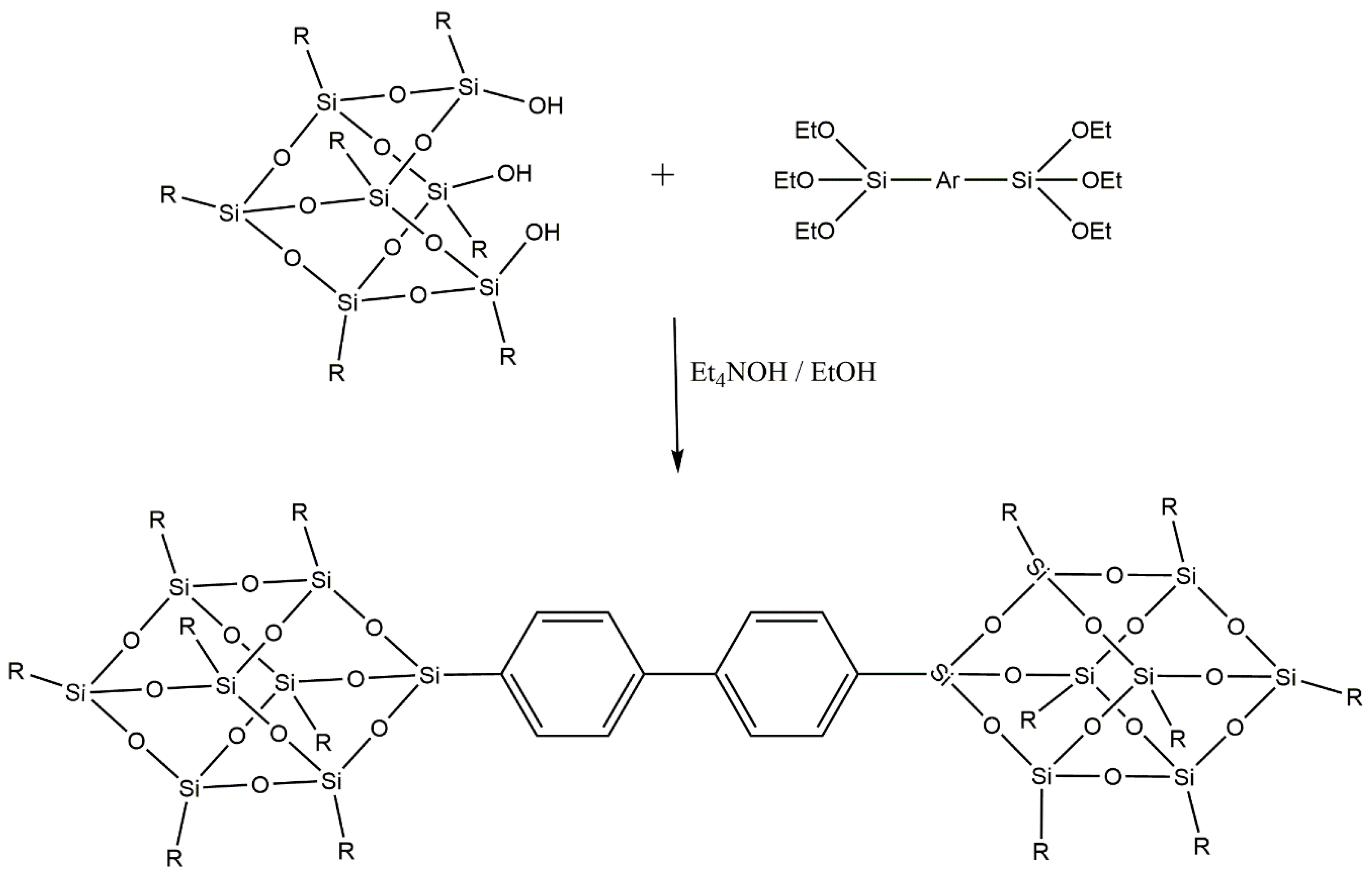
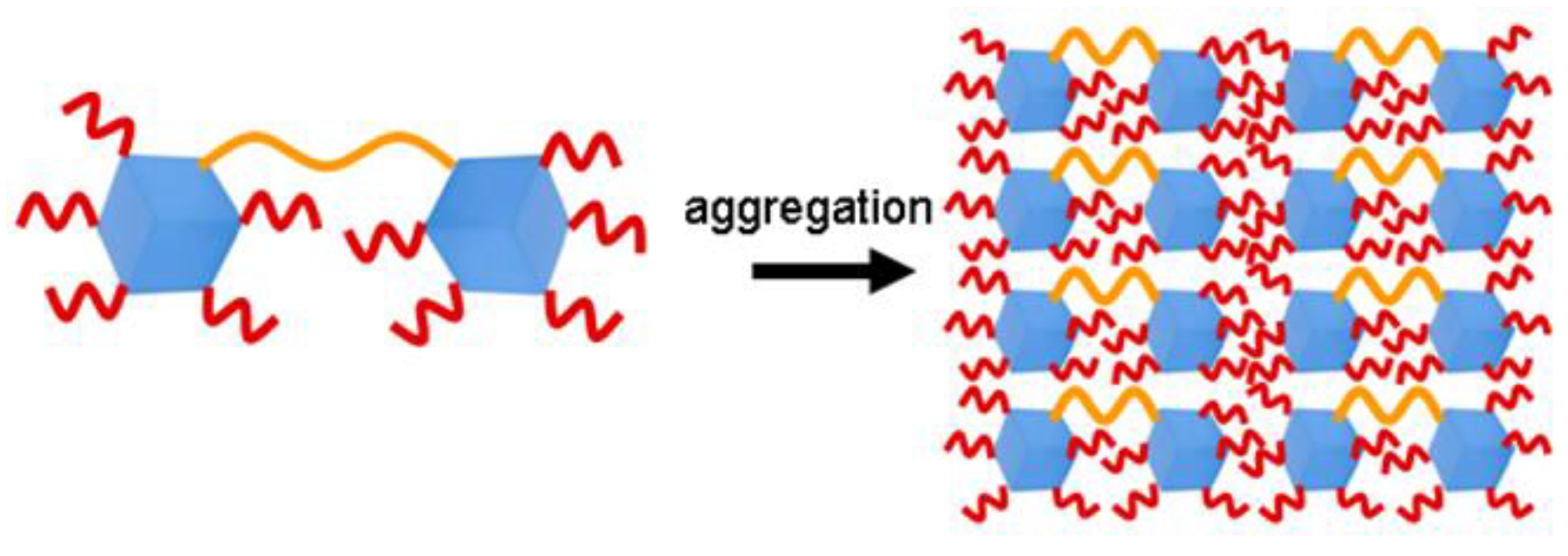
| Nanocomposites | Nitrogen | Air |
|---|---|---|
| T5%/°C | T5%/°C | |
| T (CH2)2 T/PS | 284 | 259 |
| T (CH2)4T/PS | 287 | 263 |
| T (CH2)6 T/PS | 288 | 266 |
| T (CH2)8 T/PS | 289 | 273 |
| T (CH2)10 T/PS | 293 | 282 |
© 2018 by the author. Licensee MDPI, Basel, Switzerland. This article is an open access article distributed under the terms and conditions of the Creative Commons Attribution (CC BY) license (http://creativecommons.org/licenses/by/4.0/).
Share and Cite
Blanco, I. The Rediscovery of POSS: A Molecule Rather than a Filler. Polymers 2018, 10, 904. https://doi.org/10.3390/polym10080904
Blanco I. The Rediscovery of POSS: A Molecule Rather than a Filler. Polymers. 2018; 10(8):904. https://doi.org/10.3390/polym10080904
Chicago/Turabian StyleBlanco, Ignazio. 2018. "The Rediscovery of POSS: A Molecule Rather than a Filler" Polymers 10, no. 8: 904. https://doi.org/10.3390/polym10080904




